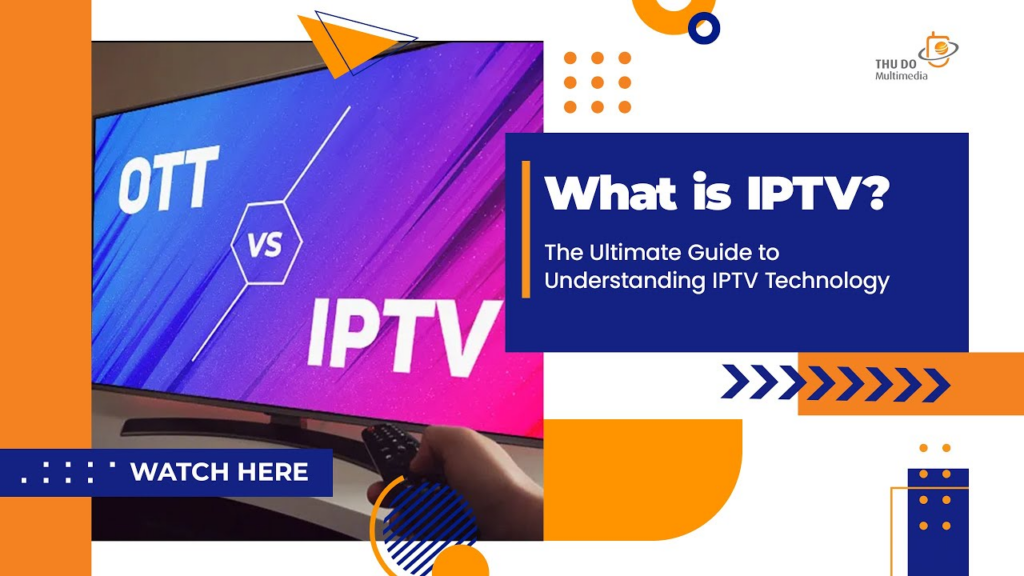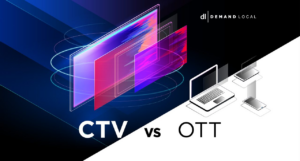The video streaming service is divided between two major technologies – OTT and IPTV.
While they sound very similar and enable access to online video content, OTT and IPTV refer to distinct content delivery systems with some key differences consumers should understand.
This comprehensive guide examines what sets OTT and IPTV apart.

Defining OTT and IPTV
OTT
OTT stands for “over-the-top” and refers to film/TV content delivered directly over the open internet to connected devices. OTT bypasses cable, broadcast, and satellite networks.
Some examples of major OTT services include:
- On-demand video services like Netflix, Prime Video, Hulu, Disney+
- Live TV streaming services like Sling TV, YouTube TV, Hulu Live
- Free ad-supported video sites like YouTube, Facebook Watch
- Transactional VOD stores like Apple’s iTunes, Google Play Movies
OTT content can be accessed on desktop computers, mobile devices, streaming boxes, and smart TVs with an internet connection.
IPTV
IPTV stands for “Internet Protocol television.” This refers to the delivery of television content over Internet Protocol networks – but unlike OTT, it relies on a managed closed system rather than the open Internet.
Some examples of IPTV services:
- Cable TV providers like Comcast and Charter offer IPTV as a delivery system for their standard cable content. This requires leasing a proprietary set-top box from your provider to decode IPTV signals and access their closed network. It does not travel over the open internet.
- Carrier IPTV like Verizon FiOS TV, which uses a similar managed network only accessible through Verizon’s set-top boxes.
- Business IPTV services in hotels, offices, etc. that distribute IPTV content over a private local network not reachable by regular internet connections.
So in summary, the key distinctions are:
- OTT – Video content delivered over the open internet.
- IPTV – Video content delivered over a closed IP network.

OTT vs. IPTV – Key Differences
While both utilize internet protocol networks for video, OTT and IPTV have some notable differences:
Delivery Architecture
The most fundamental difference lies in the underlying architecture and delivery network.
- OTT utilizes the open, public internet to deliver content directly to users. This makes it universally accessible to any device with an internet connection and OTT app.
- IPTV uses a private, closed network operated by a cable or telecom provider. This propriety IP network is tightly managed and only accessible via equipment supplied by your IPTV provider.
Accessibility
Their delivery methods impact accessibility:
- OTT – Widely accessible across all types of consumer internet-connected devices, from smartphones to smart TVs to PCs. The OTT app/service only needs to be installed or accessed via a web browser.
- IPTV – This can typically only be accessed using proprietary set-top boxes or gateways supplied by your IPTV provider. It will not work on open internet-connected devices without these approved IPTV receivers to decode the closed network signals. Accessibility is limited.

Content Sources
There are differences in where the video content originates from:
- OTT – Content is sourced directly from providers like Netflix, Hulu, Amazon, YouTube, media companies, etc. It travels over the internet to the user.
- IPTV – Content predominantly comes from traditional TV sources like cable channels, broadcast networks, and satellite programming. It is distributed over a closed IP infrastructure operated by a pay-TV provider.
User Experience
The user experience varies between the technologies:
- OTT – Primarily on-demand content with a focus on instant media streaming. But many OTT services now offer live channels. User experience is app-based.
- IPTV – Traditionally focused on replicating the linear cable TV experience with channel surfing and programming guides. But modern IPTV systems are adding on-demand and app-based features.
Costs
There are pricing differences:
- OTT – Users can access content by subscribing directly to OTT providers individually. Lots of free ad-supported OTT content also exists.
- IPTV – Requires a television subscription package from a cable/satellite operator who provides the IPTV service, usually with added hardware costs.
OTT vs IPTV – Pros and Cons
OTT Pros
- Accessible on most internet-connected devices
- On-demand viewing experience
- Direct-to-consumer content relationships
- Generally lower subscription costs
- Online user analytics and customization
OTT Cons
- Requires consistent high-speed internet
- Limited live TV options on some OTT platforms
- Fragmented subscriptions to access all content
- Lack of public viewing rights
IPTV Pros
- Integrates with cable/satellite content bundles
- Includes familiar linear television experience
- Universal accessibility of closed network infrastructure
- Public viewing rights for businesses
IPTV Cons
- Requires proprietary hardware from the TV provider
- Limited to service provider’s closed network
- Subject to cable/satellite bundle pricing
- Limited customization and analytics
Major Players in OTT and IPTV Worlds
There is an ever-growing list of providers in both spheres:
Top OTT Services
- Video on Demand – Netflix, Prime Video, Hulu, Disney+, Apple TV+, Peacock, Discovery+, Paramount+, HBO Max
- Live TV Streaming – YouTube TV, Hulu Live, Sling TV, FuboTV
- Transactional VOD – iTunes, Google Play, Vudu
- Ad-Supported – YouTube, Facebook Watch, Tubi, Pluto TV
Top IPTV Providers
- Cable Companies – Xfinity, Spectrum, Cox, Optimum
- Telecoms – Verizon FiOS, AT&T U-verse
- Satellite – DirecTV, Dish Network
- International – SKY (UK), Jio (India), Bell TV (Canada)
There are also consumer hardware and software options that support both forms of delivery:
- Streaming Media Players – Roku, Amazon Fire TV, Apple TV, Chromecast
- Smart TVs with integrated OTT and IPTV apps
- Mobile devices like smartphones and tablets
- Web browsers to access OTT directly or IPTV provider portals
So consumers have a vast and expanding array of options to access both OTT and IPTV content.

Which Approach is Better for Consumers?
OTT
It has an App-based on-demand experience, Flexible content subscriptions, Avoid traditional cable bundles, Low-cost or free options
Limitations: Fragmented apps and subscriptions, Need high-speed internet, Limited live TV choices
IPTV
Integrated live & on-demand, Familiar TV bundle model, Widespread availability, Sports and news programming
Limitations: Requires operator’s box, Subject to cable pricing, Restricted channel bundles, Limited flexibility
For most mainstream consumers, a combination of selected OTT video subscriptions plus a reasonably priced IPTV bundle from their cable/internet provider delivers the optimal blend of content breadth, viewing flexibility, and cost savings.
Heavy OTT users who are willing to navigate between apps benefit from maximum choice. Customers focused on live channels may prefer traditional IPTV bundles. Every household’s needs are different.
OTT vs. IPTV – The Bottom Line
While the technologies and business models differ, OTT and IPTV can comfortably coexist serving both mainstream television and niche online audiences. Here are some concluding takeaways:
- OTT brings flexible on-demand streaming over the open internet. IPTV enables traditional TV bundles over closed networks.
- Consumers are increasingly turning to OTT for cost and choice while supplementing with IPTV for live channels.
- IPTV operators must improve apps and hybrid TV options to stop cord-cutting losses to pure OTT services.
- OTT providers need to continue filling out channel lineups and adding live programming.
- Ultimately, OTT and IPTV will converge into hybridized next-generation video delivery systems for the streaming era.
The best path forward is an integrated model harnessing IP networks for both customized OTT streaming and seamless linear IPTV, creating the ideal television experience consumers are seeking.

Frequently Asked Questions (FAQ)
Q1. Is Netflix OTT or IPTV?
Ans. Netflix is an OTT service, delivering on-demand video content directly over the open internet rather than a closed IPTV network. Subscribers access Netflix video through apps on internet-connected devices, without needing a proprietary IPTV set-top box or network gateway.
Q2. Is YouTube TV OTT or IPTV?
Ans.YouTube TV is an OTT-based live TV streaming service, delivered over the public internet. Users can access YouTube TV’s live channels directly in a web browser or app without any special IPTV equipment.
Q3. Can you get local channels on OTT services?
Ans. Many major live TV OTT streaming services like YouTube TV, Hulu Live, and DirecTV Stream provide local broadcast network affiliates like ABC, NBC, CBS, and Fox based on your location. Local channel availability on OTT depends on regional rights.
Q4. Is IPTV available without cable?
Ans. Typically no, IPTV requires a subscription to a participating television provider like a cable company, satellite operator, or telecom that operates the closed IPTV network. OTT is the method for accessing streaming video without traditional cable or satellite bundles.
Q5. Is IPTV considered streaming?
Ans. While IPTV does deliver video over internet protocol networks, it is not considered true streaming since it relies on closed private networks rather than traveling openly over the internet. Most definitions of “streaming” refer specifically to OTT content delivered over the open internet.



